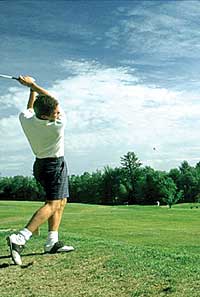 Those who play the game know some of the reasons why golf is not considered a cheap sport. Even in a country like the United States, which has around 20,000 golf courses, there is still the perception that the game is not easily affordable. So what makes golf expensive, and what can be done to make it more affordable?
Those who play the game know some of the reasons why golf is not considered a cheap sport. Even in a country like the United States, which has around 20,000 golf courses, there is still the perception that the game is not easily affordable. So what makes golf expensive, and what can be done to make it more affordable? As with many other sports, equipment can be cheap and reasonable, or top of the line using advanced designs and technology. Because the equipment used does make a difference in golf, people go for the latest, newest and therefore higher costing models, creating the impression that golf is an expensive sport. However, one does not need to start by spending so much. The first steps are getting the basics of the golf swing in place, and for this, many cheaper beginners clubs and balls work just fine.
Building a world class golf course is not easy or cheap. To start with, there is the requirement of about 100 acres (roughly 1,000 ropanis) of land. Finding suitable land of that size in a good area, and then investing in it is a tremendous challenge. Architect fees follow, which for a qualified and competent architect can range from a $100,000 to over $1 million. Finally there are the costs of building the course, which includes earth movement, irrigation, drainage, landscaping, and building the club house, car parks, roads, practice ranges and so on. Quite a daunting investment even for the private sector.
Once the course is built, must be maintained. Imagine the machinery, fuel and labour needed for cutting, maintaining and watering 100 acres of grass and natural areas. If done well, the effects can be summed up as: 'beautiful but expensive'.
Outside Nepal, governments have realized the potential of the sport, and have allocated public land and funds to build golf courses for tourism, sports promotion and recreation, environmental conservation and to give cities open green spaces. It is estimated that by the year 2005 there will be 30,000 golf courses and 85 million golfers world wide.
Has the rest of the world gone crazy, or is Nepal sleeping through another missed opportunity? Policy makers need to understand what this sport brings to a country, and to allocate land for both social and public municipal courses, which, if well run, can sustain themselves and provide the sport at an affordable level. This is the only way for more people to be encouraged to take up the sport.
The new tourism policy imaginatively proclaims promoting Nepal as a 'Sahasik' tourism destination. Well Mr (and Ms) policy makers: here's a chance for defining the nature and extent of what is meant by that policy, instead of just using adventurous words.
Deepak Acharya is a golf instructor and Head Golf Professional at Gokarna Forest Golf Resort & Spa, Kathmandu. [email protected]



